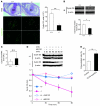Death effector domain-containing protein (DEDD) is required for uterine decidualization during early pregnancy in mice
- PMID: 21135503
- PMCID: PMC3007159
- DOI: 10.1172/JCI44723
Death effector domain-containing protein (DEDD) is required for uterine decidualization during early pregnancy in mice
Abstract
During intrauterine life, the mammalian embryo survives via its physical connection to the mother. The uterine decidua, which differentiates from stromal cells after implantation in a process known as decidualization, plays essential roles in supporting embryonic growth before establishment of the placenta. Here we show that female mice lacking death effector domain-containing protein (DEDD) are infertile owing to unsuccessful decidualization. In uteri of Dedd-/- mice, development of the decidual zone and the surrounding edema after embryonic implantation was defective. This was subsequently accompanied by disintegration of implantation site structure, leading to embryonic death before placentation. Polyploidization, a hallmark of mature decidual cells, was attenuated in DEDD-deficient cells during decidualization. Such inefficient decidualization appeared to be caused by decreased Akt levels, since polyploidization was restored in DEDD-deficient decidual cells by overexpression of Akt. In addition, we showed that DEDD associates with and stabilizes cyclin D3, an important element in polyploidization, and that overexpression of cyclin D3 in DEDD-deficient cells improved polyploidization. These results indicate that DEDD is indispensable for the establishment of an adequate uterine environment to support early pregnancy in mice.
Figures






Similar articles
-
Overexpression of cyclin D3 improves decidualization defects in Hoxa-10(-/-) mice.Endocrinology. 2012 Nov;153(11):5575-86. doi: 10.1210/en.2012-1528. Epub 2012 Sep 24. Endocrinology. 2012. PMID: 23008516 Free PMC article.
-
Control of regional decidualization in implantation: Role of FoxM1 downstream of Hoxa10 and cyclin D3.Sci Rep. 2015 Sep 9;5:13863. doi: 10.1038/srep13863. Sci Rep. 2015. PMID: 26350477 Free PMC article.
-
Evidence for coordinated interaction of cyclin D3 with p21 and cdk6 in directing the development of uterine stromal cell decidualization and polyploidy during implantation.Mech Dev. 2002 Feb;111(1-2):99-113. doi: 10.1016/s0925-4773(01)00614-1. Mech Dev. 2002. PMID: 11804782 Free PMC article.
-
Implantation and decidualization in rodents.J Exp Zool. 1993 Sep 1;266(6):603-28. doi: 10.1002/jez.1402660610. J Exp Zool. 1993. PMID: 8371101 Review.
-
Two distinct controls of mitotic cdk1/cyclin B1 activity requisite for cell growth prior to cell division.Cell Cycle. 2007 Jun 15;6(12):1419-25. Epub 2007 May 7. Cell Cycle. 2007. PMID: 17592253 Review.
Cited by
-
The decidua-the maternal bed embracing the embryo-maintains the pregnancy.Semin Immunopathol. 2016 Nov;38(6):635-649. doi: 10.1007/s00281-016-0574-0. Epub 2016 Jun 10. Semin Immunopathol. 2016. PMID: 27287066 Free PMC article. Review.
-
The fatty acid beta-oxidation pathway is important for decidualization of endometrial stromal cells in both humans and mice.Biol Reprod. 2014 Feb 20;90(2):34. doi: 10.1095/biolreprod.113.113217. Print 2014 Feb. Biol Reprod. 2014. PMID: 24403548 Free PMC article.
-
Glucosamine inhibits decidualization of human endometrial stromal cells and decreases litter sizes in mice.Biol Reprod. 2013 Jul 25;89(1):16. doi: 10.1095/biolreprod.113.108571. Print 2013 Jul. Biol Reprod. 2013. PMID: 23718985 Free PMC article.
-
Polycomb repressive complex 1 controls uterine decidualization.Sci Rep. 2016 May 16;6:26061. doi: 10.1038/srep26061. Sci Rep. 2016. PMID: 27181215 Free PMC article.
-
Metabolism-induced oxidative stress and DNA damage selectively trigger genome instability in polyploid fungal cells.EMBO J. 2019 Oct 1;38(19):e101597. doi: 10.15252/embj.2019101597. Epub 2019 Aug 26. EMBO J. 2019. PMID: 31448850 Free PMC article.
References
-
- Wang H, Dey SK. Roadmap to embryo implantation: clues from mouse models. Nat Rev Genet. 2006;7(3):185–199. - PubMed
Publication types
MeSH terms
Substances
LinkOut - more resources
Full Text Sources
Molecular Biology Databases
Miscellaneous

